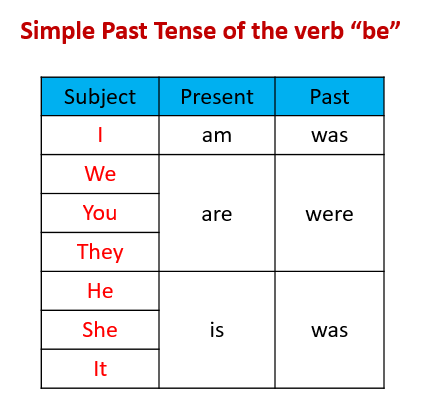

Past Tense - Be
Welcome to our free online collection of English as a Second Language (ESL) tools & resources for students, teachers, and educators.
We have lots of free videos that will help you improve your English and also advice and tips that will help you in English proficiency examinations like TOEFL and IELTS.
The following diagram gives the present tense and past tense of the irregular verb "to be". Scroll down the page for more examples and solutions.
This is an introduction to using "To Be" (was and were) in the past tense.
Examples are given in affirmative sentences (no negatives or questions).
Examples of simple time expressions such as:
Present: now, right now, and at the moment
Past: yesterday, last night, last week, last month, last year
How to join sentences in the Past with sentences in the Present tense with the conjunction "but"?
"But" is used to contrast or show a difference or change in what has already been mentioned.
e.g. They were noisy last night, but they are quiet now.
be - past tense
This video shows how to use the verb "be" in the past tense
The verb "be" in the past tense
This video shows how to conjugate the verb be in the affirmative and the negative The Verb "Be" - Present and Past Tense
This video shows the difference between the verb "be" in the past and the present tense. The Verb "Be" -- Past Tense Questions and Answers
A teacher shows how to make yes-no questions and answers in the past tense using the verb "be." Using "be" and "do" in the past tense
A teacher shows the differences between "be" and "do" in the past tense when making statements, negatives, and questions.


We have lots of free videos that will help you improve your English and also advice and tips that will help you in English proficiency examinations like TOEFL and IELTS.
The following diagram gives the present tense and past tense of the irregular verb "to be". Scroll down the page for more examples and solutions.

This is an introduction to using "To Be" (was and were) in the past tense.
Examples are given in affirmative sentences (no negatives or questions).
Examples of simple time expressions such as:
Present: now, right now, and at the moment
Past: yesterday, last night, last week, last month, last year
How to join sentences in the Past with sentences in the Present tense with the conjunction "but"?
"But" is used to contrast or show a difference or change in what has already been mentioned.
e.g. They were noisy last night, but they are quiet now.
This video shows how to use the verb "be" in the past tense
This video shows how to conjugate the verb be in the affirmative and the negative The Verb "Be" - Present and Past Tense
This video shows the difference between the verb "be" in the past and the present tense. The Verb "Be" -- Past Tense Questions and Answers
A teacher shows how to make yes-no questions and answers in the past tense using the verb "be." Using "be" and "do" in the past tense
A teacher shows the differences between "be" and "do" in the past tense when making statements, negatives, and questions.
Try the free Mathway calculator and
problem solver below to practice various math topics. Try the given examples, or type in your own
problem and check your answer with the step-by-step explanations.



We welcome your feedback, comments and questions about this site or page. Please submit your feedback or enquiries via our Feedback page.